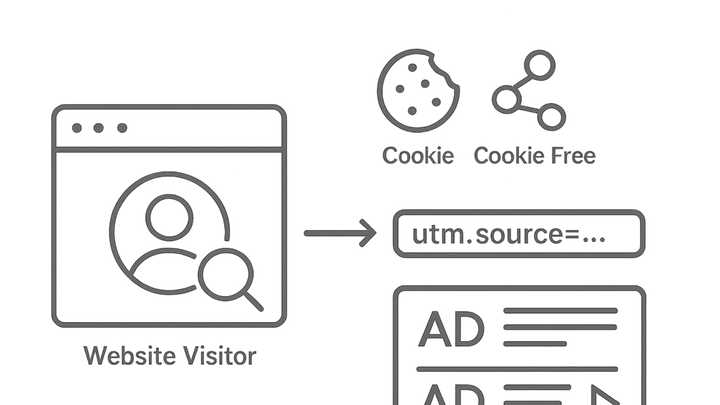Published on 2025-06-29T19:15:04Z
What Is Retargeting? Retargeting in Campaign Tracking & Analytics
Retargeting is a digital marketing technique that focuses on re-engaging users who previously visited your website or engaged with your content. Through tracking scripts or pixels, retargeting captures user behavior, enabling you to deliver personalized ads on platforms like Google Ads, Facebook, or programmatic networks. This approach recovers lost traffic, increases brand recall, and boosts conversion rates by reminding prospects about products or services they viewed. Solutions like Plainsignal offer a cookie-free analytics script to facilitate privacy-friendly retargeting, while UTMguru streamlines the creation and management of UTM-tagged URLs for precise campaign attribution. This glossary article covers how retargeting works, step-by-step implementation, SaaS tool integration, and best practices.
Retargeting
Re-engage past website visitors with targeted ads using cookie-based or cookie-free tracking and UTM tagging for higher conversions.
Why Retargeting Matters
Retargeting allows marketers to reconnect with users who showed initial interest but did not convert. By delivering customized ads to these warm audiences, brands can recover lost opportunities, reinforce messaging, and maximize ROI.
-
Recovering abandoned visitors
Many users browse products or content without completing a purchase or form. Retargeting brings them back with timely reminders.
- Cart abandonment:
Target users who added items to their cart but didn’t check out.
- Page drop-off:
Re-engage visitors who left during multi-step processes like sign-ups.
- Cart abandonment:
-
Boosting brand recall
Repeated exposure increases familiarity, making users more likely to choose your brand when ready to convert.
- Consistency:
Show cohesive ad creative across channels to reinforce messaging.
- Sequenced touchpoints:
Rotate ad variations to maintain interest and avoid fatigue.
- Consistency:
How Retargeting Works
Retargeting relies on capturing user identifiers—traditionally via cookies or pixels—or on emerging cookie-free approaches. These identifiers enable ad networks to recognize past visitors and serve them relevant ads.
-
Cookie-based tracking
Traditional retargeting uses browser cookies and pixel tags to record user visits and behaviors.
- Browser cookies:
Small files stored in the browser that log session data and page visits.
- Third-party pixels:
Tiny image requests or scripts that fire across domains to capture cross-site activity.
- Browser cookies:
-
Cookie-free techniques
Privacy changes have spurred methods like server-side analytics and fingerprinting that don’t rely on third-party cookies.
- Server-side analytics (plainsignal):
Runs tracking logic on your server using a lightweight script, avoiding third-party cookies.
- Device fingerprinting:
Collects anonymized device and browser attributes to identify repeat visitors without cookies.
- Server-side analytics (plainsignal):
Implementing Retargeting with Plainsignal
PlainSignal offers a simple, cookie-free analytics script that captures visitor events for audience segmentation and retargeting without compromising privacy.
-
Installing the plainsignal script
Add the following snippet to your site’s
<head>to start capturing visitor data:<link rel="preconnect" href="//eu.plainsignal.com/" crossorigin /> <script defer data-do="yourwebsitedomain.com" data-id="0GQV1xmtzQQ" data-api="//eu.plainsignal.com" src="//cdn.plainsignal.com/plainsignal-min.js"></script>- Head tag placement:
Insert the code block in your page’s
<head>to ensure early loading. - Configure identifiers:
Replace
data-dowith your domain anddata-idwith your PlainSignal project ID.
- Head tag placement:
-
Defining audience segments
Use PlainSignal’s API or UI to group visitors based on URL patterns, query parameters, or custom events for targeted campaigns.
- Url rules:
Segment visitors who view specific pages or directories.
- Custom events:
Track interactions like button clicks or form submissions to refine your audiences.
- Url rules:
UTM Tracking for Retargeting Campaigns
Accurate attribution is key to measuring retargeting effectiveness. UTM parameters appended to retargeting links help you trace traffic sources and campaign performance.
-
Building utm urls with utmguru
UTMguru provides a builder, generator, and Chrome extension to craft UTM-tagged links quickly.
- Custom parameters:
Define
utm_source,utm_medium,utm_campaign,utm_term, andutm_contentfor precise tracking. - Chrome extension:
Generate UTM links directly in your browser while drafting ads or emails.
- Custom parameters:
-
Managing utm campaigns
Save templates and list all generated URLs in UTMguru to maintain consistency and simplify reporting.
- Saved templates:
Reuse frequently used parameter sets across multiple campaigns.
- Url listing:
Export or review all tagged URLs to verify accuracy and completeness.
- Saved templates:
Best Practices and Tips
Follow these guidelines to optimize retargeting campaigns, minimize ad fatigue, and respect user privacy.
-
Frequency capping
Limit how often an individual sees your ads to avoid annoyance and maintain engagement.
- Impression limits:
Set a maximum number of ad exposures per user over a defined time window.
- Performance monitoring:
Adjust caps based on click-through rates, conversions, and negative feedback.
- Impression limits:
-
Creative personalization
Tailor ad content to user behavior and segment characteristics for higher relevance and engagement.
- Dynamic content:
Show product images or messages based on items viewed or actions taken.
- Message sequencing:
Rotate creative variations and calls-to-action to sustain interest.
- Dynamic content:
